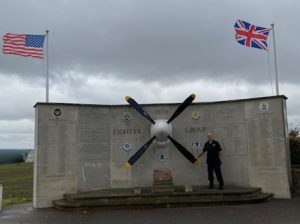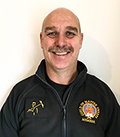 On some days we work in an area away from our usual patch around Saffron Walden and Haverhil. Thursday last week was just such a day, when we were working in and around Royston. Our first job of the day was in Littlington and the second job was in Gilden Morden. Driving between these two villages we saw the impressive memorial in the photo. This is the memorial to the 355th Fighter Group that was stationed at Gilden Morden from July 1943 to July 1945 during World War II. The spinner and propeller on the memorial are from a P-51 Mustang.
On some days we work in an area away from our usual patch around Saffron Walden and Haverhil. Thursday last week was just such a day, when we were working in and around Royston. Our first job of the day was in Littlington and the second job was in Gilden Morden. Driving between these two villages we saw the impressive memorial in the photo. This is the memorial to the 355th Fighter Group that was stationed at Gilden Morden from July 1943 to July 1945 during World War II. The spinner and propeller on the memorial are from a P-51 Mustang.
RAF Bomber Command use
Between 1940 and September 1942, Steeple Morden was a grass satellite dispersal airfield used by No. 11 Operational Training Unit of RAF Bomber Command flying Vickers Wellingtons from RAF Bassingbourn. During this time No. 3 (Coastal) Operational Training Unit RAF (OTU) also used the airfield.
USAAF use
When the airfield was turned over for American use, Steeple Morden was assigned USAAF designation Station 122. Hard-surface runways were laid down, along with concrete hardstands and a permanent T-2 hangar.
3d Photographic Reconnaissance Group
Although not planned for use until 1943 Steeple Morden was first used by the United States Army Air Forces Eighth Air Force 3d Photographic Reconnaissance Group, arriving from RAF Membury on 16 October 1942. The 3d consisted of the 5th, 12th, 13th, 14th, 15th and 23d squadrons and only stayed at the airfield until 10 December, departing for La Senia Algeria as part of Operation Torch. During the stay of the 3d PRG, Lieutenant-Colonel Elliott Roosevelt, son of Franklin D. Roosevelt served as commander and also flew an F-4 “Lightning”.
Between January 1943 and May 1943 the airfield was used by No. 17 OTU which used Bristol Blenheims.
355th Fighter Group
With the departure of the photo-recon squadrons, the 355th Fighter Group, arrived from Philadelphia Municipal Airport on 9 July 1943.[6] The group was under the command of the 65th Fighter Wing of the VIII Fighter Command. Aircraft of the group were identified by white around their cowling and tail.
The group consisted of the following squadrons:
- 354th Fighter Squadron (WR)
- 357th Fighter Squadron (OS)
- 358th Fighter Squadron (YF)
The 355th FG flew its first combat mission, a fighter sweep over Belgium, on 14 September 1943 and afterwards served primarily as escort for Boeing B-17 Flying Fortress/Consolidated B-24 Liberator bombers that attacked industrial areas of Berlin, marshalling yards at Karlsruhe, an airfield at Neuberg, oil refineries at Misburg, synthetic oil plants at Gelsenkirchen, locks at Minden, and other objectives. The group also flew fighter sweeps, area patrols, and bombing missions, striking such targets as air parks, locomotives, bridges, radio stations, and armoured cars.
On 5 April 1944, shortly after converting from Republic P-47 Thunderbolts to North American P-51 Mustangs, the group successfully bombed and strafed German airfields during a snow squall, a mission for which the group was awarded a Distinguished Unit Citation. The group provided fighter cover for Allied forces landing in Normandy on 6 June 1944, and afterwards hit transportation facilities to cut enemy supply lines. Hit fuel dumps, locomotives, and other targets in support of ground forces during the breakthrough at Saint-Lô in July.
The 355th Fighter Group flew its last combat mission on 25 April 1945. On 3 July the group transferred to Gablingen, Germany for duty with United States Air Forces in Europe as part of the army of occupation. Transferred, without personnel and equipment, to Mitchel Field New York on 1 August 1946, and was inactivated on 20 November.


 My name is Paddy McKeown, I am a retired police officer (Detective Sergeant – Metropolitan Police), turned chimney sweep. I have completed training with ‘The Guild of Master Chimney Sweeps’, and Rod Tech UK (Power Sweeping).
My name is Paddy McKeown, I am a retired police officer (Detective Sergeant – Metropolitan Police), turned chimney sweep. I have completed training with ‘The Guild of Master Chimney Sweeps’, and Rod Tech UK (Power Sweeping).




Comments are closed.